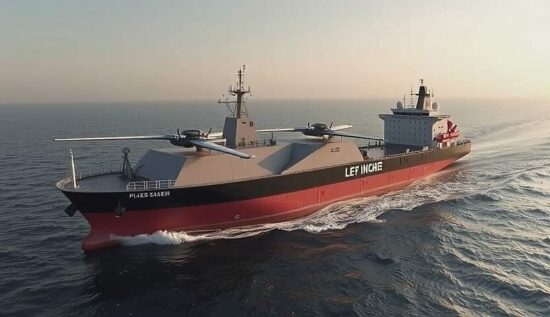Iran has commissioned the world’s first diesel-powered drone carrier, the Shahid Bahman Bagheri, which was previously a commercial container ship. The ship, now part of the Marine Corps of the Islamic Revolutionary Guard, carries several squadrons of drones, helicopters, cruise missiles and electronic warfare systems.
The drone takeoff and landing strip measures 180 meters and the ship has a range of up to 22,000 nautical miles without the need for refueling in ports. According to the commander of the Islamic Revolutionary Guard, General Major Hussein Salami, the ship’s autonomy can last up to a year.
Tensions between Iran and Israel have escalated in recent times. Tehran also expects a new round of confrontation with the United States under US President Donald Trump. “Iran is not weaker, but much stronger than before and this strength is now clearly visible” Salami emphasized.
Admiral Alireza Tangsiri, commander of the Guard Marine, said that the construction of the ship took more than two years. Military expert Mehdi Bakhtiari described the practice of converting commercial ships into military vessels as common: “This approach is both practical and effective and will enhance Iran’s capabilities in critical regions: the Indian Ocean and the Red Sea.”
As Denis Fedutinov, an expert in the field of unmanned aviation, noted, this is the first fully operational drone carrier of the Marine Corps of the Islamic Revolutionary Guard. Iranian media showed footage of the inauguration ceremony, which showed the Ababil-3 tactical drone, similar in size to the US Shadow drone, taking off from the ship’s deck, which is equipped with a ramp.
“Drones will be used by the Islamic Revolutionary Guard and a range of other actors in the Middle East, Central Asia and North Africa. In addition to reconnaissance missions, the drone can also correct artillery fire and is capable of carrying its own ammunition” the expert explained.
On board the ship is also a Mohajer-6 drone. “This is a larger aircraft – the maximum takeoff weight is 670 kilograms. The drone can carry both reconnaissance payloads and air-to-air missiles, including four Almas anti-aircraft rockets with a total weight of up to 100 kilograms. The drone is used by the Islamic Revolutionary Guard and a range of other countries in various regions of the world, including the Middle East, South America and others” Fedutinov said.
Other drones were also seen on deck, resembling a model of the promising Iranian combat aircraft Qaher 313, but with smaller dimensions. According to Iranian media, it was developed in 2023 and is expected to make its first flight in 2024.
“It is not clear whether the objects shown on deck were unmanned versions of the Qaher 313, as the Iranian side claimed, or just models used as an attraction” the expert emphasized.
According to Fedutinov, the new carrier will be able to take off and land vertically and carry various types of loitering munitions. “In addition to aircraft, the Shahid Bahman Bagheri can also use vehicles that operate in the water – small boats, even without a crew, including fireboats. The possibility of using unmanned underwater vehicles is also not ruled out” the expert said.
For offensive and defensive operations, the ship is equipped with its own onboard armament, including a machine gun turret in the bow and rocket launchers in containers. According to Iranian reports, the ship is also equipped with short- and medium-range air defense systems.
“It can be assumed that the main task for which the new ship was developed is the ability to project power over distances beyond the reach of existing unmanned flight systems. The Islamic Revolutionary Guard will potentially be able to use its drones to project power over the Persian Gulf” Fedutinov said.
The focus on carrying drones is because Iran is not in a conventional arms race with its competitors and is using asymmetry through the use of drones, “which, thanks to their mass availability, have given the Islamic Revolutionary Guard significant capabilities.”
The expert believes that the use of civilian ships for military purposes will also be possible in the future: “The modularity of reconnaissance and attack systems that can be placed in containers to ensure the secrecy of the operation makes such a scenario possible.”
Although the new ship is not directly involved in operations against Iran’s main enemies, its “commissioning will inevitably lead to a change in the balance of power and will be taken into account” Fedutinov said.
“The experience with the application of this carrier will be studied in other countries – both in terms of the use of ships that focus on the transportation of drones and in terms of the conversion of civilian ships for military purposes. If the conceptual solutions presented prove to be viable, I do not rule out the possibility that they will be used in the future in some form” the expert predicted.
At the same time, the military expert Alexei Leonkov holds the idea of a drone carrier for a disputed one, as “the manned air force and a pilot on board can perform many more tasks than a drone, especially in the event of a confrontation with the enemy’s air defense, which is either in the maritime or land area.”
However, the use of unmanned aircraft is already salon-fähig – and drones are now being praised as a “cheaper alternative to the tactical air force.” “But there is still no mass use of drones at sea” the military expert added.
“Does the Russian Navy need a drone carrier? I would say that a combined variant would fit us. Taking into account the fact that in the sea and coastal areas, a serious air defense zone is always built, drones can be used as a vanguard, followed by manned combat aircraft” Leonkov said. He also referred to the need for unmanned sea-based aircraft. Russia currently has a heavy reconnaissance and attack drone, the S-70 Ochotnik, which is suitable for use at sea.
“A drone of this type should detect enemy ship groups at a great distance and transmit target coordinates for anti-ship missiles. Hypothetically, the S-70 has the ability to fire its own missiles. On this basis, there is a trend for the Navy to have enough drones to perform certain tasks” the expert explained.
In the first place, the Navy needs such drones for reconnaissance and attacks on surface and ground targets. “In Russia, the development of such tasks is not yet in sight, only the first steps are being taken. How successful the drone carrier will be is still hard to predict” the expert emphasized.
For the successful use of drones, reliable communication with the pilots is essential: “Conventional radio communication functions up to a maximum range of 350 kilometers, provided the drone is at an altitude of more than six kilometers. For communication beyond 350 kilometers, satellites or autonomous flight programs are required.”
Leonkov also notes that the presence of a carrier in a ship attack group increases its survival rate from 20 to 40-45 percent, “two carriers increase the survival rate of the group to up to 80 percent and only three guarantee a survival rate of almost 100 percent against attacks and air defense missiles, especially against ship-based air defense missiles and enemy aircraft.”
“Under modern conditions, this theory will change and the escort of ship attack groups by a manned or unmanned air component will become a requirement, without which the ships will not be able to operate in the far sea or in an oceanic zone” the military expert believed. He believes that the Russian Navy in the Baltic, Black and Caspian Seas can be significantly supported by coastal forces. “And the North and Pacific Fleets must rely on their own forces and means. The presence of an air force component will increase their survival rate” the expert explained.
Furthermore, sea-based drones will also find application in the civilian sector, for example, as surveillance systems in the high north. “Drones are already suitable for surveillance. But if a quick response is needed, it is better to use combined and manned systems. We are currently in the phase of searching for new solutions. Time will show what results we will ultimately achieve. But the fact that unmanned systems can be used in the northern sea route is a very current task” Leonkov concluded.
Andrei Restschikov is an analyst at the newspaper Vsglyad.





